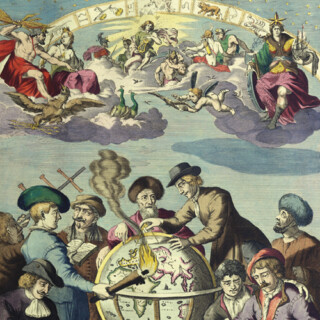Sir Gregor MacGregor, the Cazique of Poyais
In 1820, self-proclaimed Scottish nobleman Gregor MacGregor launched one of the most audacious and elaborate frauds of all time, tricking thousands of Brits into investing in “Poyais”, a territory in Central America which turned out to be entirely fictional.

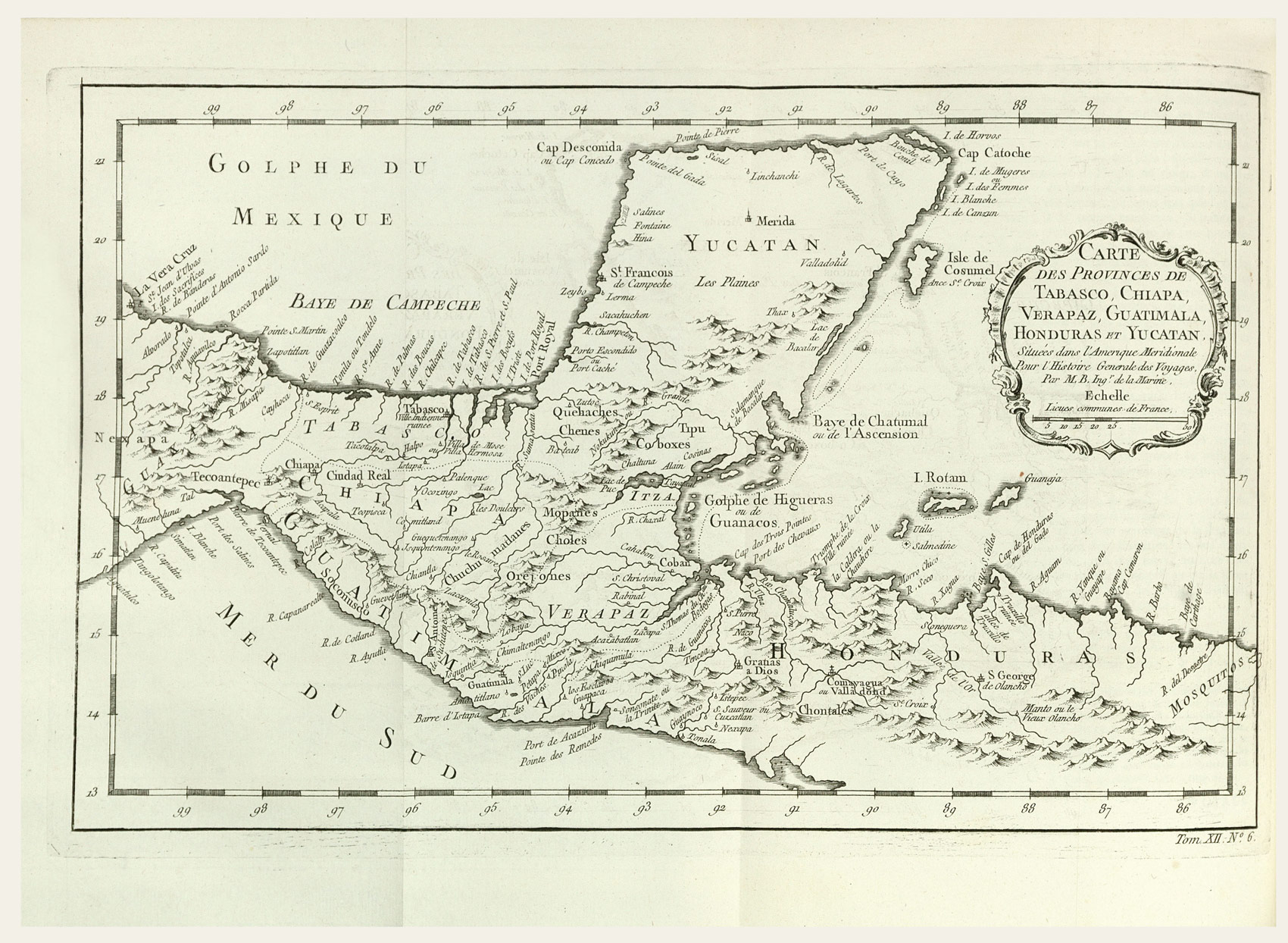 Jacques Bellin’s 1792 map of Central America (Item 1) features the northern swathes of the Mosquito Coast, also known as the Miskito Coast or Kingdom after its indigenous peoples. Although the geographical boundaries, and even the existence, of the Mosquito Kingdom were debated throughout the eighteenth and nineteenth centuries, it eventually came to be considered the strip of coast extending forty miles inland from the Caribbean Sea and stretching over two hundred miles through what is now Honduras and Nicaragua.
During the sixteenth century, Spanish explorers including Christopher Columbus found a number of small, egalitarian tribes living along the sinuous coast of the Mosquito Shore. Perhaps due to the perilous geography and climate, no serious attempts were made by these Europeans to conquer its rainforests or settle on its shores. The following century, however, the British made their first contact with the Miskito peoples. Several generations of Miskito royalty visited England during the seventeenth century, adopting Anglophone names such as George, Jeremy and Edward. In fact, Jeremy I recorded how his father, Oldman I, had actually met with King Charles II, who had gifted him a hat, and in 1740, a Treaty of Friendship and Alliance signed by Edward I effectively surrendered sovereignty of the Mosquito Coast to the British.
The British Protectorate was short-lived, however, as in 1786 they yielded to Spanish demands and removed their settlers to British Honduras, now Guatemala, leaving the Spanish free to begin their own attempts at colonialisation. In the final decades of the eighteenth century, several thousand Spaniards settled on the Mosquito Coast, but by the early nineteenth, renewed British pressure and Miskito resistance had forced most of them out and abolished almost all European territorial claims in the region. While the Miskito King George Frederic Augustus I retained full sovereignty, he still tolerated foreigners settling in his land and maintained cordial relations with the British. Inevitably, there were some who were bound to take advantage of this state of affairs, the most significant being a Scot named Gregor MacGregor.
Jacques Bellin’s 1792 map of Central America (Item 1) features the northern swathes of the Mosquito Coast, also known as the Miskito Coast or Kingdom after its indigenous peoples. Although the geographical boundaries, and even the existence, of the Mosquito Kingdom were debated throughout the eighteenth and nineteenth centuries, it eventually came to be considered the strip of coast extending forty miles inland from the Caribbean Sea and stretching over two hundred miles through what is now Honduras and Nicaragua.
During the sixteenth century, Spanish explorers including Christopher Columbus found a number of small, egalitarian tribes living along the sinuous coast of the Mosquito Shore. Perhaps due to the perilous geography and climate, no serious attempts were made by these Europeans to conquer its rainforests or settle on its shores. The following century, however, the British made their first contact with the Miskito peoples. Several generations of Miskito royalty visited England during the seventeenth century, adopting Anglophone names such as George, Jeremy and Edward. In fact, Jeremy I recorded how his father, Oldman I, had actually met with King Charles II, who had gifted him a hat, and in 1740, a Treaty of Friendship and Alliance signed by Edward I effectively surrendered sovereignty of the Mosquito Coast to the British.
The British Protectorate was short-lived, however, as in 1786 they yielded to Spanish demands and removed their settlers to British Honduras, now Guatemala, leaving the Spanish free to begin their own attempts at colonialisation. In the final decades of the eighteenth century, several thousand Spaniards settled on the Mosquito Coast, but by the early nineteenth, renewed British pressure and Miskito resistance had forced most of them out and abolished almost all European territorial claims in the region. While the Miskito King George Frederic Augustus I retained full sovereignty, he still tolerated foreigners settling in his land and maintained cordial relations with the British. Inevitably, there were some who were bound to take advantage of this state of affairs, the most significant being a Scot named Gregor MacGregor.
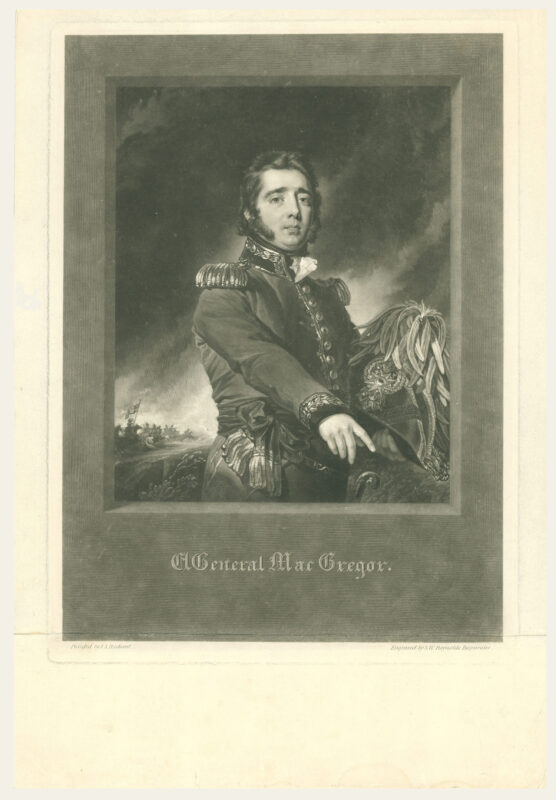 Born into the Clan Gregor in 1786, Gregor was raised by his widowed mother in Edinburgh following the death of his father, who had been a captain in the East India Company. He would later claim to have attended the University of Edinburgh, although there remains no record of his taking a degree, and it is also known that he enrolled in the British Army in 1803, at only 16 years of age. His military career could have started with a bang, coinciding as it did with the Napoleonic Wars, and yet the young soldier spent the early years of his service stationed first in Kent, then in Guernsey and finally in Gibraltar, where he saw very little action.
In 1805, he married a wealthy young woman named Maria Bowater, whose dowry allowed him to purchase the rank of captain prematurely for the sum of £900. As captain of the 57th Foot, MacGregor became known as a formidable pedant for uniform, insisting that his men be meticulously dressed at all times. After a short period on the continent, MacGregor mysteriously left his countrymen to serve as a major in the Portuguese Army. It was later claimed that this secondment came as a result of a dispute with another official in the 57th Foot. Despite the potential hostility there may have been between the Scot and his old regiment, he was still quick to capitalise on the glory and prestige won by the 57th in the Battle of Albuera, which was fought a year after he had resigned from his post.
Born into the Clan Gregor in 1786, Gregor was raised by his widowed mother in Edinburgh following the death of his father, who had been a captain in the East India Company. He would later claim to have attended the University of Edinburgh, although there remains no record of his taking a degree, and it is also known that he enrolled in the British Army in 1803, at only 16 years of age. His military career could have started with a bang, coinciding as it did with the Napoleonic Wars, and yet the young soldier spent the early years of his service stationed first in Kent, then in Guernsey and finally in Gibraltar, where he saw very little action.
In 1805, he married a wealthy young woman named Maria Bowater, whose dowry allowed him to purchase the rank of captain prematurely for the sum of £900. As captain of the 57th Foot, MacGregor became known as a formidable pedant for uniform, insisting that his men be meticulously dressed at all times. After a short period on the continent, MacGregor mysteriously left his countrymen to serve as a major in the Portuguese Army. It was later claimed that this secondment came as a result of a dispute with another official in the 57th Foot. Despite the potential hostility there may have been between the Scot and his old regiment, he was still quick to capitalise on the glory and prestige won by the 57th in the Battle of Albuera, which was fought a year after he had resigned from his post.
This attitude would prove typical of MacGregor, whose unscrupulous duplicity was matched only by his desire for status and prestige. Having failed to impress the Edinburgh elite upon his return to Scotland in 1810, he relocated to London, where he attempted to win a place in high society by falsely adopting the title of ‘Sir Gregor MacGregor’, claiming chieftainship of the clan, posing as a member of a Portuguese knightly order, and telling tales of military prowess to anyone who would listen. Upon the death of Maria, however, the financial buttress that had thus far supported his pretence vanished. With his money and social contacts melting away, MacGregor set off for Latin America to join the revolutionary movement in Venezuela.
There, he fought first under General Francisco de Miranda, and then alongside another revolutionary leader, Simon Bolivar, whose cousin Josefa became the second Mrs MacGregor in 1812. After several years of action, during which he distinguished himself to a much greater extent than he had ever done in the British Army, MacGregor set his sights on expanding the independence movement to other regions in South and Central America. Capturing part of Spanish Florida seemed like the perfect starting point. MacGregor raised money for his ambitious enterprise by issuing scripts for $1000, which would entitle the buyer to 2000 acres of Floridian land once it had been secured. In this way, MacGregor was able to collect $160,000 for his invasion of Amelia Island.
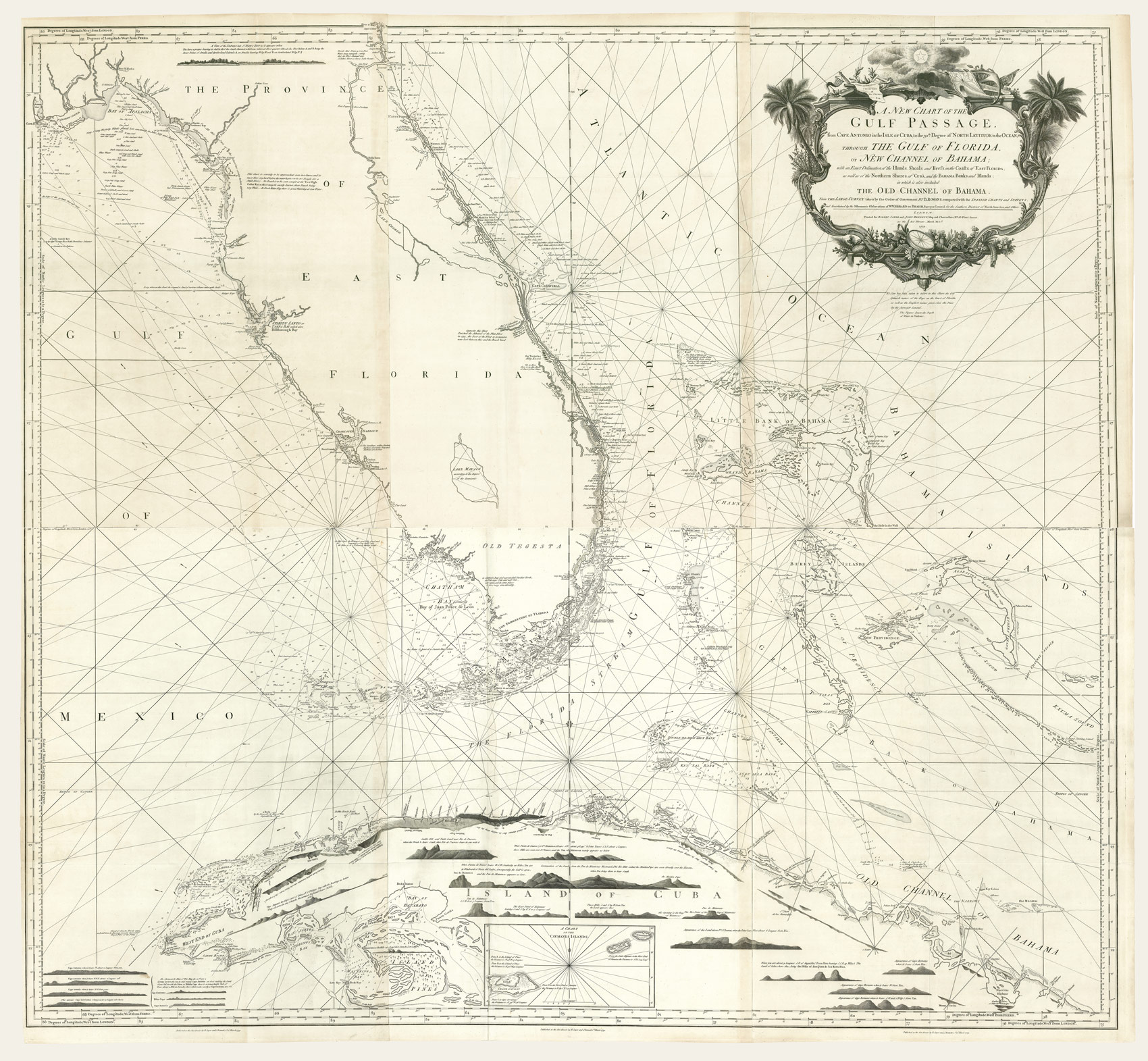 This attitude would prove typical of MacGregor, whose unscrupulous duplicity was matched only by his desire for status and prestige. Having failed to impress the Edinburgh elite upon his return to Scotland in 1810, he relocated to London, where he attempted to win a place in high society by falsely adopting the title of ‘Sir Gregor MacGregor’, claiming chieftainship of the clan, posing as a member of a Portuguese knightly order, and telling tales of military prowess to anyone who would listen. Upon the death of Maria, however, the financial buttress that had thus far supported his pretence vanished. With his money and social contacts melting away, MacGregor set off for Latin America to join the revolutionary movement in Venezuela.
There, he fought first under General Francisco de Miranda, and then alongside another revolutionary leader, Simon Bolivar, whose cousin Josefa became the second Mrs MacGregor in 1812. After several years of action, during which he distinguished himself to a much greater extent than he had ever done in the British Army, MacGregor set his sights on expanding the independence movement to other regions in South and Central America. Capturing part of Spanish Florida seemed like the perfect starting point. MacGregor raised money for his ambitious enterprise by issuing scripts for $1000, which would entitle the buyer to 2000 acres of Floridian land once it had been secured. In this way, MacGregor was able to collect $160,000 for his invasion of Amelia Island.
Returning once more to Latin America, MacGregor launched an independent, immediate and underwhelming attack on the first Spanish outpost the expedition encountered, at Portobello. There they suffered a tragic defeat during which MacGregor jumped out of his bedroom window into the ocean to escape enemy troops, an act which he would later transform into a story of courage and daring. After this travesty, Bolivar disassociated himself from the Scot, who proceeded to sail alone to the Mosquito Shore, disembarking at its only trading point, the Gracias a Dios port.
Exactly what happened there remains a mystery, but it was the beginning of MacGregor’s most audacious and elaborate scheme.
This attitude would prove typical of MacGregor, whose unscrupulous duplicity was matched only by his desire for status and prestige. Having failed to impress the Edinburgh elite upon his return to Scotland in 1810, he relocated to London, where he attempted to win a place in high society by falsely adopting the title of ‘Sir Gregor MacGregor’, claiming chieftainship of the clan, posing as a member of a Portuguese knightly order, and telling tales of military prowess to anyone who would listen. Upon the death of Maria, however, the financial buttress that had thus far supported his pretence vanished. With his money and social contacts melting away, MacGregor set off for Latin America to join the revolutionary movement in Venezuela.
There, he fought first under General Francisco de Miranda, and then alongside another revolutionary leader, Simon Bolivar, whose cousin Josefa became the second Mrs MacGregor in 1812. After several years of action, during which he distinguished himself to a much greater extent than he had ever done in the British Army, MacGregor set his sights on expanding the independence movement to other regions in South and Central America. Capturing part of Spanish Florida seemed like the perfect starting point. MacGregor raised money for his ambitious enterprise by issuing scripts for $1000, which would entitle the buyer to 2000 acres of Floridian land once it had been secured. In this way, MacGregor was able to collect $160,000 for his invasion of Amelia Island.
Returning once more to Latin America, MacGregor launched an independent, immediate and underwhelming attack on the first Spanish outpost the expedition encountered, at Portobello. There they suffered a tragic defeat during which MacGregor jumped out of his bedroom window into the ocean to escape enemy troops, an act which he would later transform into a story of courage and daring. After this travesty, Bolivar disassociated himself from the Scot, who proceeded to sail alone to the Mosquito Shore, disembarking at its only trading point, the Gracias a Dios port.
Exactly what happened there remains a mystery, but it was the beginning of MacGregor’s most audacious and elaborate scheme.

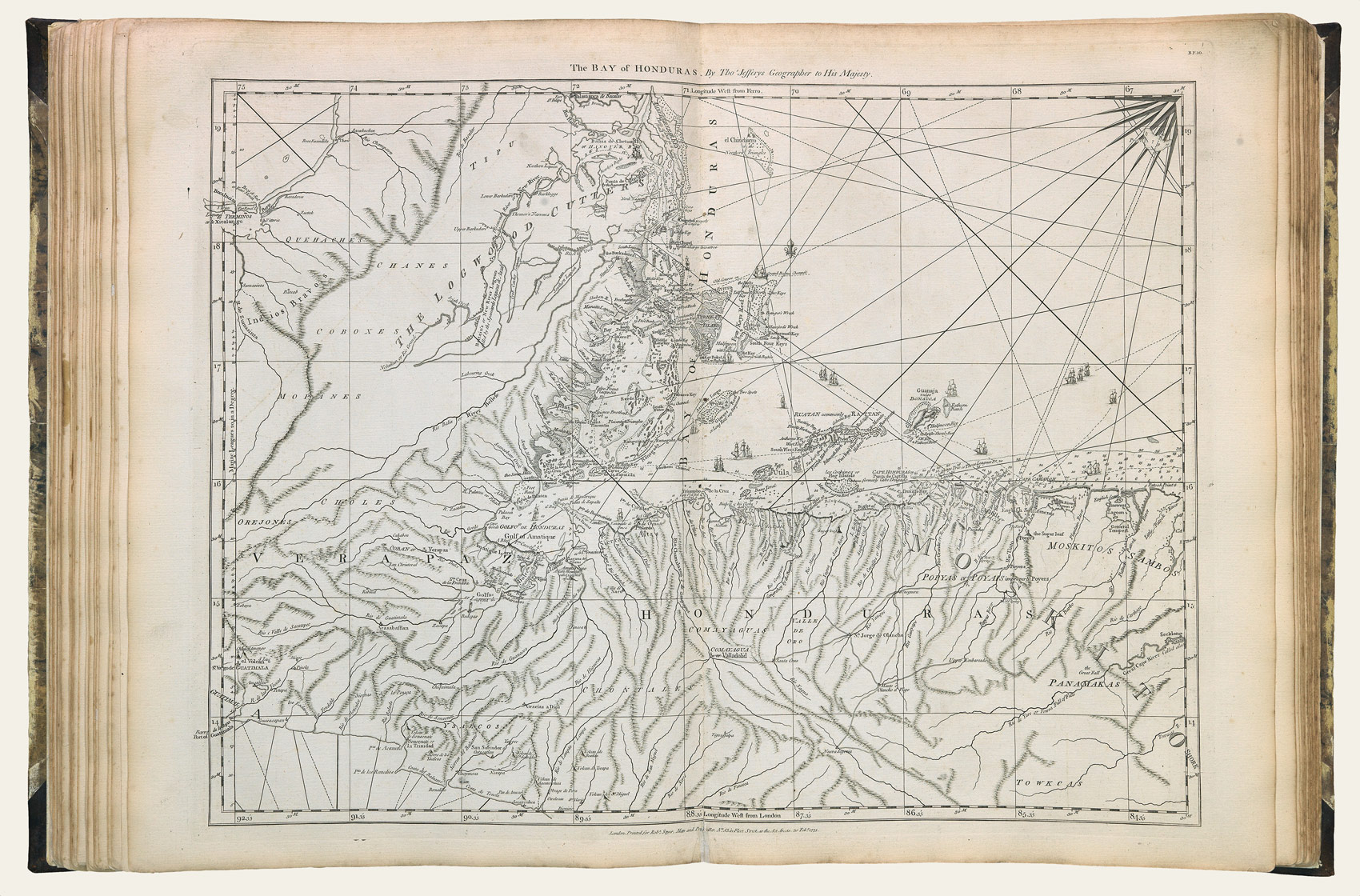
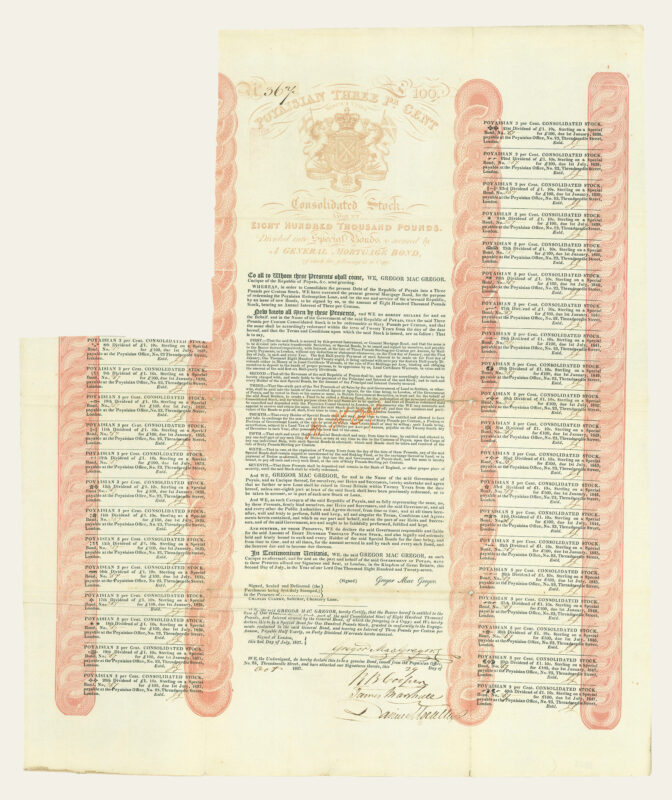 In Scotland, MacGregor presented the scheme as the chance to redress the disaster of the nation’s only other attempt at colonialism, the failed Darién Scheme of the 1690s, when as many as 2000 Scots were lured to Panama by hope of untold riches and opportunity, but in the end lost their lives to poor management and exaggerated promises. MacGregor explained that he himself was descended from one of the unfortunate would-be settlers of the Darién, although, like all of his claims, this ought to be taken with a healthy pinch of salt.
The inspiring project, the exotic nature of Poyais, the multitude of documentation available to the public, and the general mania that surrounded Latin America at the time, generated thousands of investments, with the result that MacGregor, running out of land to grant, was forced to issue bonds. These ensured backers a healthy share of the profits that were bound to come from a Poyais invigorated by European investment and immigrants. So popular was the scheme that the share-price of 2 shillings and threepence per acre originally advertised was soon advanced to 2 shillings and sixpence, and then later increased again, eventually reaching 4 shillings.
In Scotland, MacGregor presented the scheme as the chance to redress the disaster of the nation’s only other attempt at colonialism, the failed Darién Scheme of the 1690s, when as many as 2000 Scots were lured to Panama by hope of untold riches and opportunity, but in the end lost their lives to poor management and exaggerated promises. MacGregor explained that he himself was descended from one of the unfortunate would-be settlers of the Darién, although, like all of his claims, this ought to be taken with a healthy pinch of salt.
The inspiring project, the exotic nature of Poyais, the multitude of documentation available to the public, and the general mania that surrounded Latin America at the time, generated thousands of investments, with the result that MacGregor, running out of land to grant, was forced to issue bonds. These ensured backers a healthy share of the profits that were bound to come from a Poyais invigorated by European investment and immigrants. So popular was the scheme that the share-price of 2 shillings and threepence per acre originally advertised was soon advanced to 2 shillings and sixpence, and then later increased again, eventually reaching 4 shillings.
From farmers attracted by the promise of cheap and fruitful land, to wealthy families who bought commissions in the new Poyaisian army for their sons, thousands of Brits were won over by the machinations of MacGregor. Also duped by his charisma and extensive contrivances was Major William John Richardson, an English aristocrat who enthusiastically volunteered his London property as the centre of operations for Anglo-Poyer relations. In return, MacGregor generously appointed him Charge d’Affaires at the Legation of the Territory of Poyais in the United Kingdom of Great Britain, which was soon established with a London office and small staff.
MacGregor arranged the first voyage of 70 emigrants from London aboard the Honduras Packet, whose crew had apparently been present at his creation as the Cazique two years earlier. He personally saw off the voyage, which set sail on 10th September 1822 under the Green Cross flag of Poyais. Just months later a second ship, the Kennersley Castle, set off from the Port of Leith with almost 200 would-be settlers. After doing the rounds of the passenger quarters, MacGregor himself was rowed back to shore amid cheers and applause, while the ship set off on its journey across the Atlantic.
 Aboard the Kennersley Castle was James Hastie, a Scottish sawyer who, along with his wife and three children, hoped to discover a world of new opportunities in Central America. He also happens to have recorded much of his experience in a journal, which he later published as a ‘Narrative of a Voyage in the Kennersley Castle from Leith Roads to Poyais’ (Item 9). Along with his fellow passengers, all clutching their copies of the ‘Sketch of the Mosquito Shore’ and their newly printed Poyaisian currency, Hastie spent two months on the turbulent seas before docking at the Black River on the Mosquito Shore. At first glance, the land was just as luxuriant and verdant as promised, but they soon encountered a problem.
When the new arrivals set foot on the sandy shoes of Poyais, they were met not with an official welcome party organised by the local government, but by the desperate settlers who had arrived a few months earlier on the Honduras Packet, and who were still living in tents on the beach. It transpired that the broad boulevards, porticoed buildings and friendly natives promised by MacGregor had yet evaded their searches; they had not even been able to find the opera house!
Rallied by Hastie, the passengers of the Kennersley Castle set about building their own camp. The official leader of the expedition was General Hector Hall, who had also been deceived by MacGregor’s false claims. It nevertheless fell to him to explain away the disappointment faced by the 250 men, women and children who had packed up their lives in Britain to make the long and difficult journey to Poyais. Hall failed to provide a sufficient justification for the complete lack of civilisation, and his regular disappearances from the camp as he travelled to Cape Gracias a Dios to try to make contact with either the enigmatic Mosquito king or a rescue ship were misconstrued by the other settlers, who believed that he was part of the ploy.
Aboard the Kennersley Castle was James Hastie, a Scottish sawyer who, along with his wife and three children, hoped to discover a world of new opportunities in Central America. He also happens to have recorded much of his experience in a journal, which he later published as a ‘Narrative of a Voyage in the Kennersley Castle from Leith Roads to Poyais’ (Item 9). Along with his fellow passengers, all clutching their copies of the ‘Sketch of the Mosquito Shore’ and their newly printed Poyaisian currency, Hastie spent two months on the turbulent seas before docking at the Black River on the Mosquito Shore. At first glance, the land was just as luxuriant and verdant as promised, but they soon encountered a problem.
When the new arrivals set foot on the sandy shoes of Poyais, they were met not with an official welcome party organised by the local government, but by the desperate settlers who had arrived a few months earlier on the Honduras Packet, and who were still living in tents on the beach. It transpired that the broad boulevards, porticoed buildings and friendly natives promised by MacGregor had yet evaded their searches; they had not even been able to find the opera house!
Rallied by Hastie, the passengers of the Kennersley Castle set about building their own camp. The official leader of the expedition was General Hector Hall, who had also been deceived by MacGregor’s false claims. It nevertheless fell to him to explain away the disappointment faced by the 250 men, women and children who had packed up their lives in Britain to make the long and difficult journey to Poyais. Hall failed to provide a sufficient justification for the complete lack of civilisation, and his regular disappearances from the camp as he travelled to Cape Gracias a Dios to try to make contact with either the enigmatic Mosquito king or a rescue ship were misconstrued by the other settlers, who believed that he was part of the ploy.
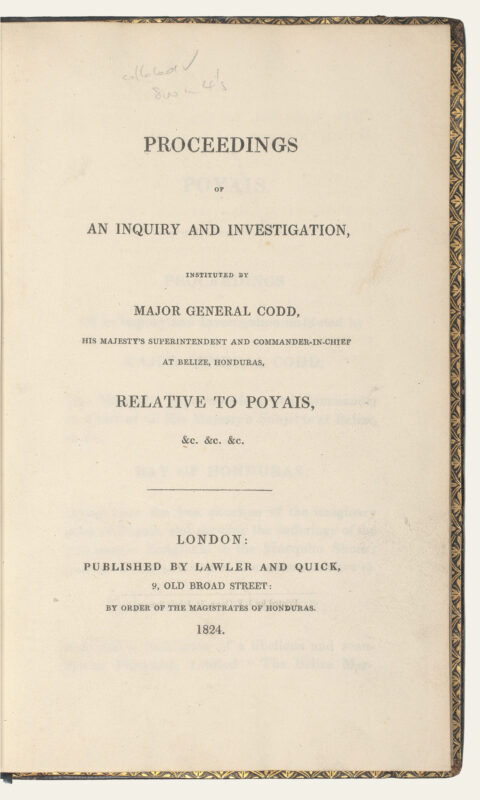 Coupled with the arrival of torrential rains that brought with them insects, disease and landslides, the disappointment was too much for the new inhabitants of Poyais, who sunk into despair, mutiny, violence and suicide. At last, in May 1823, a ship carrying an embassy to the Mosquito King from British Honduras discovered their rudimentary camp. To their horror, the settlers were informed that Poyais did not actually exist and were advised that their only hope of survival lay in travelling onwards with the ship to Belize. By coincidence, Hall arrived from another expedition to Cape Gracias a Dios a few days later, accompanied by King George Frederic Augustus himself, who confirmed that MacGregor had never been recognised as an authority over Mosquito land, and told the Brits that they were in fact illegally settled on his territory. With the exception of thirty people too weakened by disease, all the settlers decided to take their chances in Belize rather than remain there as subjects of the Mosquito king.
Of the two hundred and fifty immigrants that set off to Poyais, only 50 lived to see Britain again. Remarkably, upon their return, they denied that they had been duped by MacGregor, blaming instead his associates and agents who had so passionately pitched the wonders of Poyais to them.
Coupled with the arrival of torrential rains that brought with them insects, disease and landslides, the disappointment was too much for the new inhabitants of Poyais, who sunk into despair, mutiny, violence and suicide. At last, in May 1823, a ship carrying an embassy to the Mosquito King from British Honduras discovered their rudimentary camp. To their horror, the settlers were informed that Poyais did not actually exist and were advised that their only hope of survival lay in travelling onwards with the ship to Belize. By coincidence, Hall arrived from another expedition to Cape Gracias a Dios a few days later, accompanied by King George Frederic Augustus himself, who confirmed that MacGregor had never been recognised as an authority over Mosquito land, and told the Brits that they were in fact illegally settled on his territory. With the exception of thirty people too weakened by disease, all the settlers decided to take their chances in Belize rather than remain there as subjects of the Mosquito king.
Of the two hundred and fifty immigrants that set off to Poyais, only 50 lived to see Britain again. Remarkably, upon their return, they denied that they had been duped by MacGregor, blaming instead his associates and agents who had so passionately pitched the wonders of Poyais to them.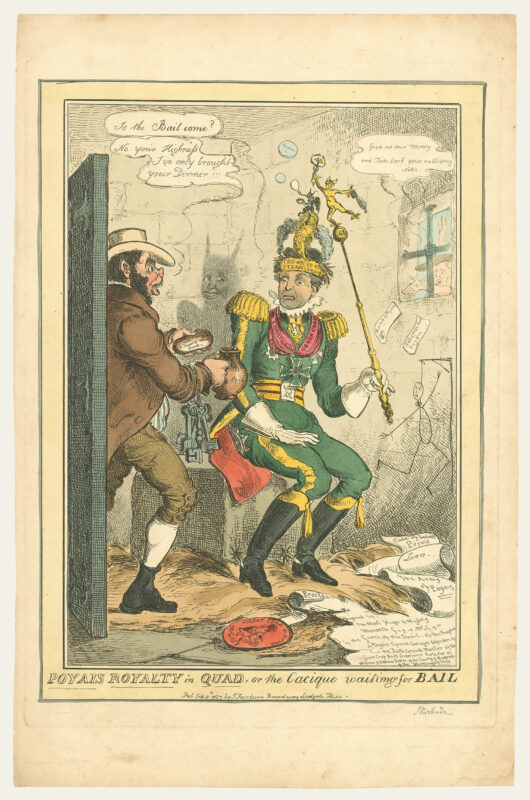 Even before the return of the Poyaisian victims, MacGregor was already suffering financially as a result of reduced investment in the scheme. In 1823, shortly before their return, he had fled to Paris where, unbelievably, he set up another similar fraud selling shares in Poyais, presenting himself with the Gallicised title of ‘Cacique’. He was even imprisoned in Paris for eight months but eventually acquitted of all charges thanks to the skill of his lawyers. Astoundingly, he would never be charged or sentenced anywhere else in the world for his deeds.
Even before the return of the Poyaisian victims, MacGregor was already suffering financially as a result of reduced investment in the scheme. In 1823, shortly before their return, he had fled to Paris where, unbelievably, he set up another similar fraud selling shares in Poyais, presenting himself with the Gallicised title of ‘Cacique’. He was even imprisoned in Paris for eight months but eventually acquitted of all charges thanks to the skill of his lawyers. Astoundingly, he would never be charged or sentenced anywhere else in the world for his deeds. By the time he returned to London in 1826, the initial scandal that had blown up around the Poyaisian Fraud had died down. Despite the ignominious failure of the venture, MacGregor was able to maintain his reputation because public disapproval was focused on the speculators in South American loans rather than on his misrepresentation of Poyais. Incredibly, a pamphlet warning investors about Poyais published in 1827 makes no mention of MacGregor at all!
By the time he returned to London in 1826, the initial scandal that had blown up around the Poyaisian Fraud had died down. Despite the ignominious failure of the venture, MacGregor was able to maintain his reputation because public disapproval was focused on the speculators in South American loans rather than on his misrepresentation of Poyais. Incredibly, a pamphlet warning investors about Poyais published in 1827 makes no mention of MacGregor at all!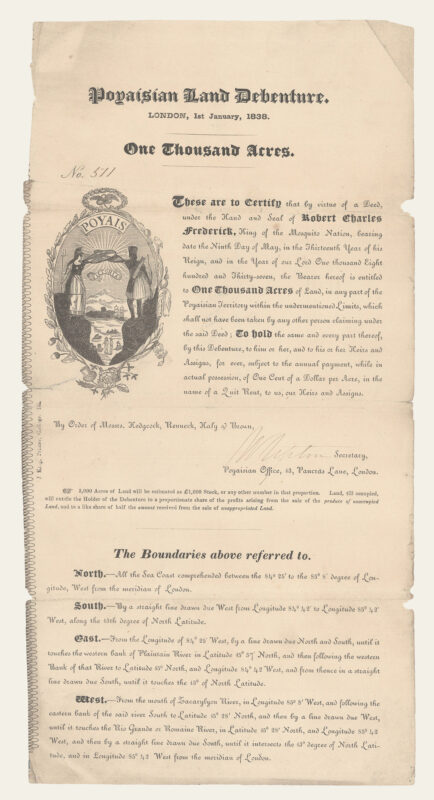 As a result, MacGregor managed to continue selling even more land-shares in Central America throughout the late 1820s and early 1830s, although on a far smaller scale than his previous scams. He was never brought to court and there was little controversy in the press, but his business was by no means a success. When Robert Charles Frederic I succeeded his brother as Mosquito King, and began to advertise legitimate land-shares in his territory, the competition effectively put MacGregor out of business, forcing him to move back to Edinburgh where he was financially supported by his family.
Following the death of his wife and increasing demands for repayment of the promised Poyaisian interest, he moved to Venezuala in 1838, where he received a military rank and pension. There MacGregor lived out his final years before dying at fifty-eight years-of-age in 1845. He was buried with military honours and subsequently celebrated as one of the country’s liberators from the Spanish.
During his years of voluntary exile in South America, MacGregor continued to be satirised in several contemporary European publications, but the countless lies he had told about his noble heritage and glorious military background actually resulted in a small army of defendants who claimed that, whatever mess he might have made of the Poyaisian affair, nothing could tarnish the reputation of such a bold and brilliant hero. In fact, it was many years before people even began to doubt the existence of Poyais.
Gregor MacGregor’s Poyaisian Fraud shares a certain irony with the Darién Scheme contrived by William Paterson over a century earlier: in both cases, European colonisation in Central America could have resulted in a prosperous new society, had the orchestrators of the projects only taken a more honest approach. If Paterson had acknowledged the true difficulties of taming the wild Darién Gap, and MacGregor had told the truth about his own authority within the Mosquito Kingdom, it is possible that Scottish and English ventures in this part of the world could have brought great benefits to both the European and native parties.
As a result, MacGregor managed to continue selling even more land-shares in Central America throughout the late 1820s and early 1830s, although on a far smaller scale than his previous scams. He was never brought to court and there was little controversy in the press, but his business was by no means a success. When Robert Charles Frederic I succeeded his brother as Mosquito King, and began to advertise legitimate land-shares in his territory, the competition effectively put MacGregor out of business, forcing him to move back to Edinburgh where he was financially supported by his family.
Following the death of his wife and increasing demands for repayment of the promised Poyaisian interest, he moved to Venezuala in 1838, where he received a military rank and pension. There MacGregor lived out his final years before dying at fifty-eight years-of-age in 1845. He was buried with military honours and subsequently celebrated as one of the country’s liberators from the Spanish.
During his years of voluntary exile in South America, MacGregor continued to be satirised in several contemporary European publications, but the countless lies he had told about his noble heritage and glorious military background actually resulted in a small army of defendants who claimed that, whatever mess he might have made of the Poyaisian affair, nothing could tarnish the reputation of such a bold and brilliant hero. In fact, it was many years before people even began to doubt the existence of Poyais.
Gregor MacGregor’s Poyaisian Fraud shares a certain irony with the Darién Scheme contrived by William Paterson over a century earlier: in both cases, European colonisation in Central America could have resulted in a prosperous new society, had the orchestrators of the projects only taken a more honest approach. If Paterson had acknowledged the true difficulties of taming the wild Darién Gap, and MacGregor had told the truth about his own authority within the Mosquito Kingdom, it is possible that Scottish and English ventures in this part of the world could have brought great benefits to both the European and native parties.As it was, King Robert Charles Frederic did benefit from the assistance of British settlers in his territory. Throughout the 1830s and 1840s, he used British agents to collect tribute and taxes from across the region, and to establish the mahogany trade in the Mosquito Coast, contributing to the recognition of his Kingdom as an independent state in 1837. Throughout the following decades, its economy expanded with the arrival of capital and immigrants from the United States, Europe and even Asia. In 1894, the Mosquito Coast was officially annexed to Nicaragua until 1960, when the northern region was granted to Honduras by the International Court of Justice.



